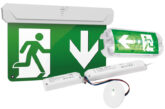
How does self-test emergency lighting work and why is it increasingly important for end-users? John Bullivant, Technical Manager at Eterna Lighting, shares his thoughts.
These days building owners and responsible persons must be able to prove that their emergency lighting systems work correctly and are maintained in full working order, with every system luminaire subjected to daily, monthly and annual testing.
Whilst testing individual emergency luminaires isn’t difficult, inspecting an entire installation for operation and duration performance can be can be extremely labour intensive and expensive.
Reducing the burden
Self-test emergency products can reduce the burden of testing emergency lighting installations as these perform all mandatory testing automatically, removing the need for the user or building owner to perform manual testing.
Monthly functional tests and annual full duration tests are automatically initiated with results shown via an LED indicator on the light – the responsible person need only check the status of the LED indicator and record the results in the log book.
Not only is this a far less time-consuming and lower-cost operation than with manual testing, it also ensures that maintenance personnel are only required to attend to lights with reported faults.
Where a fault is identified the LED indicator will report what is at fault and continue to report this until the fault has been rectified.
Purchasing self-test emergency lighting units can bring many benefits, including reducing labour costs and time. The initial costs may be higher but overall they provide a very short payback period, making them an option that should be considered when starting your project.
5 BENEFITS OF SELF-TEST EMERGENCY LIGHTING
- More effective and reliable than manual testing
- Easy to install
- Saves time and money
- Testing causes no disruption to the normal operation of the building
- Staggered tests mean all areas are protected in the event of a power failure
5 BENEFITS OF SELF-TEST EMERGENCY LIGHTING
- More effective and reliable than manual testing
- Easy to install
- Saves time and money
- Testing causes no disruption to the normal operation of the building
- Staggered tests mean all areas are protected in the event of a power failure
How it works
Each Eterna Lighting self-test product is fitted with an automatic, self-test function that will commission and test itself in accordance with the requirements of the British Standards. Monthly (ten minute functional) and annual (full three-hour duration) tests will be automatically completed as well as checks for things such as battery charge condition.
a) On installation, a date will be randomly assigned by the luminaire’s internal clock for the first monthly and first annual test.
b) The initial monthly test will be between 16 and 30 days from installation (monthly tests will then be conducted every 30 days).
c) The initial full-duration test will be between 200 and 360 days from installation (annual tests will then be conducted every 360 days).
d) The schedule of these tests will be remembered for a period of seven days, if no power is supplied to the luminaire.
All Eterna Lighting self-test products have been independently tested by TUV to ensure these are designed and manufactured to conduct self-testing in accordance with EN 62034, which specifies the performance and safety requirements for products and components incorporated into automatic test systems for emergency escape lighting.
Eterna Lighting has expanded its range of LED emergency lighting products to now include the self-test feature across much of the LED emergency category, and additionally the feature is also available with selected battens, panels, downlights and battery packs.
For more information visit: www.eterna-lighting.co.uk/self-test









